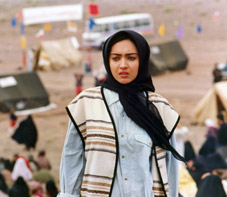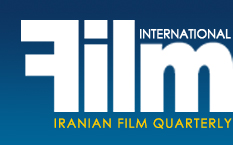|
Women in war cinema
Love and Fire
by Mehrzad Danesh
|
 The picture of eight-year Iran-Iraq war (1980-1988) in the Iranian cinema can be studied from different angles, one of which is women’s role in war. In war movies, women usually appeared as a member of combatants’ families (as mothers, wives, and daughters) and were either suffering or trying to boost soldiers’ morale. Of course, they were sometimes more directly engaged in war and attended the warfronts like nurses who went to battlefields to take care of patients at field hospitals. There were also a number of female prisoners of war and, like other wars women were vulnerable to such consequences as homelessness, rape, disability and injury as well as loss of husband, father, son or brother. Anyway, due to traditional structure of the Iranian society, women played less important roles in war than men. Therefore, cinema could be one of the best media to demonstrate their presence in that arena. The picture of eight-year Iran-Iraq war (1980-1988) in the Iranian cinema can be studied from different angles, one of which is women’s role in war. In war movies, women usually appeared as a member of combatants’ families (as mothers, wives, and daughters) and were either suffering or trying to boost soldiers’ morale. Of course, they were sometimes more directly engaged in war and attended the warfronts like nurses who went to battlefields to take care of patients at field hospitals. There were also a number of female prisoners of war and, like other wars women were vulnerable to such consequences as homelessness, rape, disability and injury as well as loss of husband, father, son or brother. Anyway, due to traditional structure of the Iranian society, women played less important roles in war than men. Therefore, cinema could be one of the best media to demonstrate their presence in that arena.
Although in the first Iranian war movie, Frontier (Jamshid Heidari, 1981) which focused on resistance against the enemy at a border village, there was a woman who took up arms and encouraged others to fight, women’s presence in the Iranian war films was low-key for many years and most of such films were about heroic acts of men. Even if a woman was to be shown, she was bound to her home in a passive way waiting for a man to return from battlefields. However, this purely masculine world gradually changed and filmmakers found out that paying attention to women will add to attractions of their films and make them look more realistic. Therefore, from the middle of 1980s, women’s passive role changed and they were given more important roles than just crying and waiting for their men to come back.
In general, presence of women in the Iranian war movies can be reviewed in a number of categories: woman in family (mother, wife, or daughter), women suffering from physical or psychological injuries (disability, rape, chemical wounds), war refugees, emotional and love affairs, and medical professions (nurses and physicians). Evidently this is not a definitive division and a woman in family, for example, may also suffer from other consequences of war.
SUBSCRIBE
[Page: 56]
|
|
|
|
|
President & Publisher
Massoud Mehrabi
Editors:
Sohrab Soori
Massoud MehrabiZohreh Khatibi
Contributors
Shahzad Rahmati
Saeed Ghotbizadeh
Advertisements
Mohammad Mohammadian
Art Director
Babak Kassiri
Ad Designers
Amir Kheirandish
Hossein Kheirandish
Cover Design
Alireza Amakchi
Correspondents
E.Emrani & M. Behraznia (Germany)
Mohammad Haghighat (France)
A. Movahed & M. Amini (Italy)
Robert Richter (Switzerland)
F. Shafaghi (Canada)
B. Pakzad (UAE)
H. Rasti (Japan)
Print Supervisors
Shad-Rang
Noghreh-Abi
Gol-Naghsh
Subscription & Advertising Sales
Address: 10, Sam St., Hafez Ave., TEHRAN, IRAN
Phone: +98 21 66722444
Fax: +98 21 66718871
info@film-magazine.com
Copyright: Film International
© All rights reserved,
2023, Film International
Quarterly Magazine (ISSN 1021-6510)
Editorial Office: 5th Floor, No. 12
Sam St., Hafez Ave., Tehran 11389, Iran
*
All articles represent views of their
authors and not necessarily
those of the editors
|
|
|

